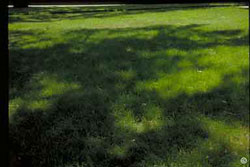How can I grow grass in shady areas?

Grass performs better in sunny locations. To obtain the best possible results in shady areas, use shade-tolerant grass mixes. Varieties of chewing fescue and creeping red fescue tolerate light shade quite well. Tall fescue has moderate shade tolerance and some varieties of Kentucky bluegrass have fair shade tolerance.
Should I mow grass differently in shady areas?
Another way to help grass that is in the shade is to raise the lawn mower height to three inches, providing a larger leaf surface for photosynthesis. And if growth rates in the shade are slower, mow less often.
How should I fertilize my grass in shady areas?
Reduce spring nitrogen fertilizer rates on shady lawns. Heavy nitrogen applications stimulate rapid growth, which makes grass prone to disease in shady areas.
Should I aerate my shady lawn?
Aerate the lawn in spring and fall. Lawn is a poor competitor in compacted soils. Trees in the area also will benefit from lawn aeration. Make enough passes with the aerator to create plug holes that are two inches inches apart. Scatter newer varieties of shade-tolerant grass seed after aerating.
How much should I water in shady areas?
Pay attention to water needs. Heavy watering in shady areas may aggravate lawn disease problems. However, if the lawn has to compete with a large tree for soil moisture, the area may become overly dry.
In heavy shade, it may be more practical to use ground covers or a wood-chip mulch with shade-loving perennials.



